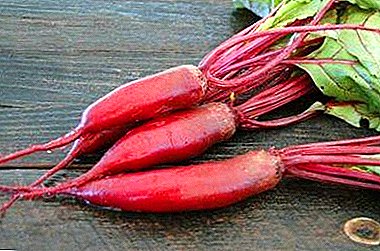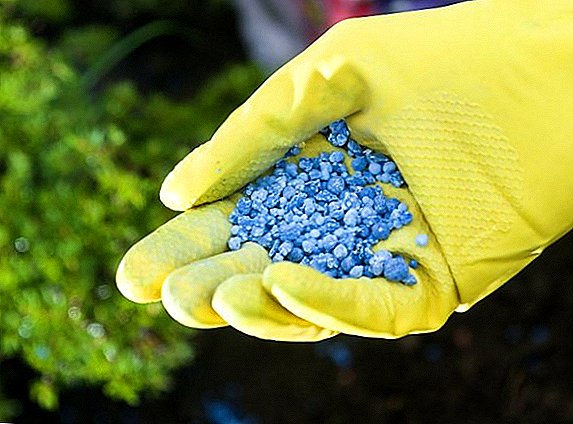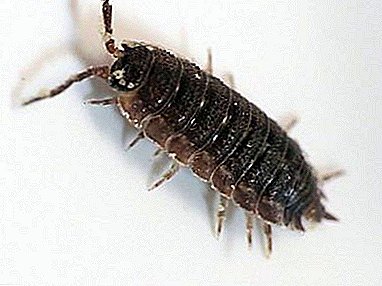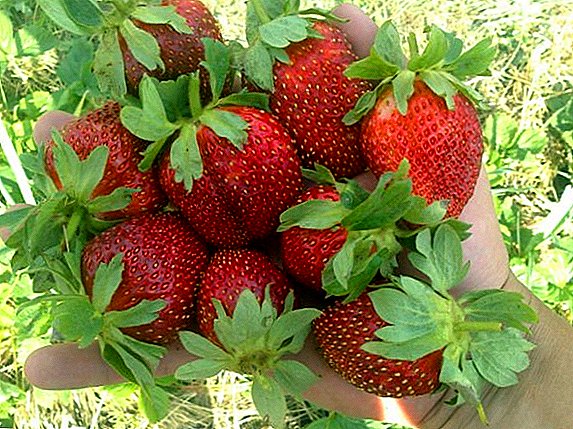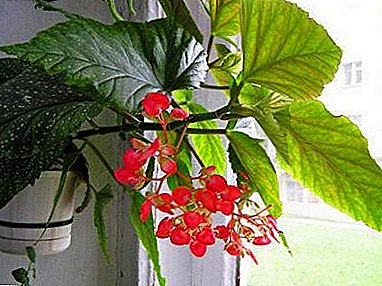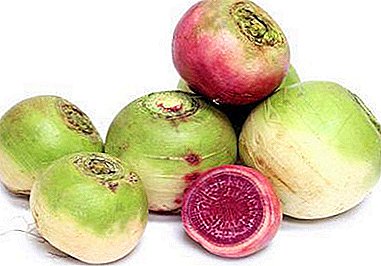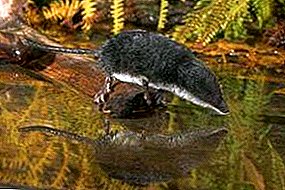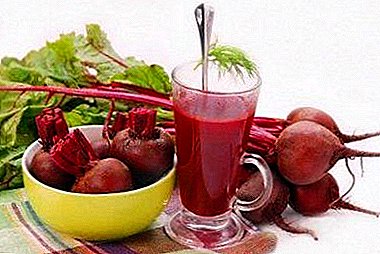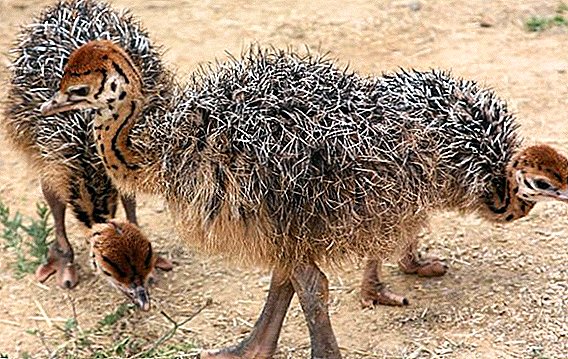 Ducks, chickens and geese are more familiar to domestic farmers, and most of them are well aware of how to ensure proper care for such poultry.
Ducks, chickens and geese are more familiar to domestic farmers, and most of them are well aware of how to ensure proper care for such poultry.
The situation with ostriches is a bit more complicated, but this does not mean that it is impossible to cope with these giants at home.
In our article we will talk about how the ostrich chicks look and what you should pay attention to when feeding and caring for them.
Ostrich chick
The ostrich nestling is an ostrich bug, born into a world strong enough and independent, able to follow the parent and look for food. That is, unlike nesting chicks, these babies are more adapted to life, which is typical of all brood species of birds (including the ducks, geese and chickens mentioned).  An ostrich female incubates its young for a long time (on average, about 40 days), so it is not surprising that their main development occurs inside the shell. After hatching, each ostrich bug weighs a little more than a kilogram and can reach a height of 20 cm.
An ostrich female incubates its young for a long time (on average, about 40 days), so it is not surprising that their main development occurs inside the shell. After hatching, each ostrich bug weighs a little more than a kilogram and can reach a height of 20 cm.
In the future, every day the young growth adds another 1 cm in its height, until it reaches a value of 1.5 m.
The whole body of newborn chicks is covered with small bristly feathers, painted in a grayish-black color (often with dark patches in the neck and brown head). A few months after the birth, the hard pubescence of the chicks is replaced by a real plumage, the body is growing rapidly, and the young can already reach speeds of up to 50 km / h.
Parents look after their children for the first two years of their lives, after which the young birds leave the family and create their own harems.
Did you know? The most popular in domestic breeding is the black African ostrich. The growth of an adult individual is 2-2.7 m, and body weight varies between 120-150 kg (depending on the sex of the bird).
Content Features
Before proceeding to the breeding of ostrichs, it is very important to create the most suitable conditions for their full-fledged growth and development. In all the preparatory activities there are a number of nuances that you just need to know about if you want to get the most effective result when raising these birds. 
The necessary conditions
In the first months of their lives, the standard premises of the poultry house, the dimensions of which will correspond to the landing density of 1 individual per 1 square meter, are ideal for keeping. m. (optimal values in the first three weeks of young animals).
In the future, the available space should be increased to 5 square meters. m per 1 bird (in such conditions the ostrichs are kept for up to six months), and then up to 10 square meters. m per 1 head. Three-month strausyat can be placed in special pens, but always with a canopy.
Discover popular ostrich species. And also find out how the ostrich and the emu live and look where it lives.
When preparing the room for birds, it is important to consider the following requirements:
- walls must be warmed and upholstered or covered with clay;
- the ideal floor is wooden, on the surface of which a bed of hay is additionally laid;
- windows and walking place should be placed on the south side;
- the ventilation system should work without failures, as the ostrich strands do not tolerate stale air;
- to divide the premises into separate sections, it is better to use boards or small-mesh nets, in which chicks or adult birds will not be able to stick their heads;
- when keeping young stock in winter, the amount of lighting should be at least 16 hours per day;
- Starting from the third week of life of chicks, the temperature indicators in the room should be maintained at a level not lower than + 20 ... + 25 ° С, while in the first days it is desirable to provide values within + 32 ... + 33 ° С;
- optimum moisture content is about 60%.
If the young growth is fattened for the purpose of further quick slaughter, then the optimal solution for its placement will be a separate pen, which must be necessarily insulated with a metal grid.  The area of free space is calculated based on a ratio of 3.2 square meters. m on one ostrich little girl. In the "baby" pens can keep chicks up to 8-10 weeks of age, and then transfer to a more spacious place.
The area of free space is calculated based on a ratio of 3.2 square meters. m on one ostrich little girl. In the "baby" pens can keep chicks up to 8-10 weeks of age, and then transfer to a more spacious place.
Did you know? Ostriches do not have other people's children. Often, adult couples try to lure the neighbors' chicks to themselves, and the females often hatch both their own and other people's eggs, placing them in one nest. By the way, if this happens, then the native testicles of the hen are necessarily located in the center of the nest.
Rules for the care of chicks
Ostrich - unpretentious bird. It perfectly transfers both cold and heat, successfully adapting to the most different climatic conditions.
Nevertheless, small chicks and young representatives still require some attention, which is expressed not only in the correctly chosen diet (about this a little later), but also in hygienic measures.
Thus, the room where young animals are kept must be cleaned of excrement every day, disinfected the feeders in a timely manner and constantly change the water. If the ventilation system does not work well, then you will have to organize additional ventilation of the room, but without drafts.  In addition, strausit must always have a clean and dry litter, otherwise it may appear harmful microorganisms, causing the development of various ailments.
In addition, strausit must always have a clean and dry litter, otherwise it may appear harmful microorganisms, causing the development of various ailments.
Important! Ostrich meat can catch any bird disease that is common in our regions, so if there have already been cases of massive death of a bird near the farm, vaccination of young animals is mandatory.
As a preventive measure, it is desirable to vaccinate the livestock, and which vaccine to choose is suggested by the veterinarian (all the same preparations are usually used as for chickens, only at a higher dosage).
What to feed
The first few days the hatched chicks do not need food, and they can not feed. They also do not need water, because the yolk sac can only completely dissolve in such conditions.
In the future, ostrich meat can be fed with the same feed as many other representatives of the agricultural bird, introducing herbs, coarse feed and mineral substances into the diet.
Learn how ostrich meat is useful, how to collect and use ostrich feathers, how ostrich fat is useful.
Minerals
As a vitamin-mineral dressing, ostrichs can be given commercial mixes, or their diet can be supplemented with natural ingredients. So, from the age of 3 weeks, separate gravel troughs can be placed at the place of their detention.  Access to it should be provided around the clock so that the chicks can take as much as they need.
Access to it should be provided around the clock so that the chicks can take as much as they need.
Among other sources of mineral substances can be identified:
- Fish meal (in the first few months, 120 g per 1 kg of live weight is given out, and later on its amount in the ration is reduced to 60 g).
- Dicalcium Phosphate: from 0 to 2 months at 5.3 g per 1 kg of live weight, from 2 to 4 months - at 7.4 g, from four months of age - 11 g.
- Calcined chalk: 0-2 months - 17 g per 1 kg of live weight, 2-4 months - 12.3 g per 1 kg of live weight, 4-6 months - 3 g / kg.
- Soybean oil: 0-2 months - 232 g per 1 kg of body weight, 2-4 months - 86 g / kg, 4-6 months - 30 g / kg.
- Vitamin and mineral premix: 4.5 g per 1 kg of body weight in the first half year.
- Feed yeast: 3-10 g per 1 kg of body weight, depending on age.
In addition to this list, oranges can be given B vitamins, each day adding them to the main feed in the amount of 5 g per chick.
Important! Some breeders feed the young litter of adult ostriches, which contributes to the colonization of the intestine with beneficial microorganisms. However, when performing such a procedure, it is necessary to be completely confident in the good health of the “supplier birds”, otherwise infection of young animals with worms is possible.
Roughage
Rough feed containing hay and haylage is suitable for feeding ostrich chicks only in winter when there is no fresh greenery on the street. The consumption rate for grown-up ostrichs corresponds to the adult rate and amounts to 1.5 kg of roughage per 1 individual.  The best is considered to be mixed hay, which includes cereals, legumes, legumes, cereals and forbs. All the rest of the year, it will be more preferable for small ostriches to be fed with wet mash from concentrated feed mixtures and chopped alfalfa (but without the stem part).
The best is considered to be mixed hay, which includes cereals, legumes, legumes, cereals and forbs. All the rest of the year, it will be more preferable for small ostriches to be fed with wet mash from concentrated feed mixtures and chopped alfalfa (but without the stem part).
The chicks eat the whole liquid food well, so for good development you will have to fill the feeders more often.
You will be interested to know why the ostrich does not fly, what ostriches are sick with, why the ostrich hides its head in the sand, what speed the ostrich develops while running.
Chicks that are not four months old are not allowed to go to alfalfa fields, so that they do not slaughter the stomach with the stems of the plant.
At the same time, it will be useful for them to simply walk freely in the yard, looking for pebbles, sand, remains of eggshell, and even lime pieces, since all this stimulates the digestive processes in their stomach.
Herbs
Ostrich meat can eat different types of herbs, but alfalfa will be most valuable for them. She is introduced into the diet of the first month of life of the chick, gradually increasing the amount from 15-20 g to 200 g per 1 kg of live weight of the bird.  It will also be useful to give young plants and some other herbs, for example:
It will also be useful to give young plants and some other herbs, for example:
- clover - starting with 20 g per 1 kg of mass and increasing the dosage as the chick grows to 200 g;
- nettle: 10-15 g per 1 kg of live weight for chicks from 1 to 3 months;
- quinoa: 15-20 g per 1 kg of live weight with an increase in dosage up to 200-250 g after the birds reach 6 months of age;
- corn silage: after a month of age at 50 g per 1 kg;
- beet leaves: at 30 g / kg body weight, starting from one month of age chicks.
A variety of vegetables (potatoes, beets, turnips, pumpkin) will be no less useful in an стра ostrich diet, and a little later you can add fruits (apples and pears) to them, also starting the feed with only a few dozen grams per 1 kg of live weight.
The total amount of feed for adolescents should be about 1 kg per day, while the adult bird eats about one and a half kilograms.
Important! Near small and large ostriches should always be clean water. One adult drinks a day at least 10 liters of liquid.
What can get sick
Although ostriches are exotic birds, they can suffer almost all the same diseases as domestic agricultural birds.  The list of the most common ailments includes:
The list of the most common ailments includes:
- Avian flu - can affect a bird at any stage of its development and is characterized by abundant mucous discharge from the eyes and nose, as well as poor appetite. Effective treatment of this disease has not yet been developed, so the only way out is to prevent infection by timely vaccination.
- Newcastle disease is more common in ostriches up to 9 months of age and can be transmitted from domestic chickens. Patients look very weak, there is a lack of coordination of movements. Accurately determine the presence of this disease is possible only through laboratory tests, but in order to prevent infection, it is necessary to vaccinate the chicks in advance.
- Encephalopathy is a disease triggered by the activity of a virus of unknown nature. The symptoms are very similar to the Newcastle disease mentioned: there is a violation of coordination of movements, breathing of the bird gets off, weakness and convulsions appear. The infusion of belladonna is often used to eliminate the symptoms and treat the disease.
- Worm infestation is a disease caused by the presence of parasitic life forms in the body and is characterized by poor appetite, weak growth and insufficient weight gain of the chicks.
- Hypoglycemia - occurs in cases where strausata does not get enough food. They weaken quickly and cannot move smoothly. As a first aid, they can inject glucose, the positive effect of which is noticeable almost immediately.
Important! Unlike other poultry, diarrhea in ostriches is very rare, and if the nestlings still have an upset stomach, then most likely this is a sign of some infectious disease.
Useful tips
Unfortunately, with mass breeding of poultry, it will not be possible to completely avoid diseases, but you can limit their distribution and protect healthy straus.  You can do this by following the following simple rules:
You can do this by following the following simple rules:
- cleaning in the ostrich farm should be carried out daily, with full disinfection of water troughs and feeders;
- in each poultry house there must be a kind of quarantine zone, where the sick or newly arrived strausita are placed;
- when working with chicks or an incubator, sterile gloves should be worn so as not to infect the babies;
- when a large number of birds is useful to regularly analyze the litter for the presence of parasites, to prevent the development of worm infestation;
- there should not be any rodents in the house, therefore, at the slightest suspicion of their presence, it is worth taking appropriate measures for destruction;
- in case of insufficient humidity, it is necessary to use the forced humidification system so that this indicator does not fall below 60%;
- Of course, we should not forget about the vaccination schedule, because vaccination is considered the most effective way to prevent a large number of diseases.
Breeding ostriches is indeed a very profitable and interesting business, which, unfortunately, cannot be called very easy. However, if you follow all the above recommendations, you will be able to minimize possible problems, still achieving high results.


